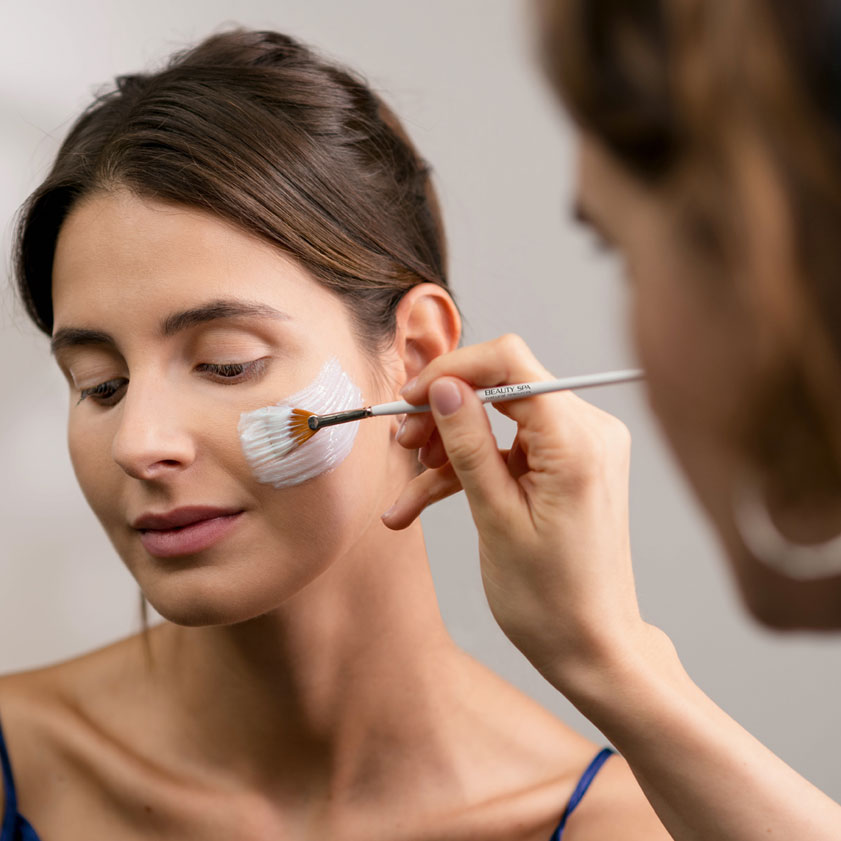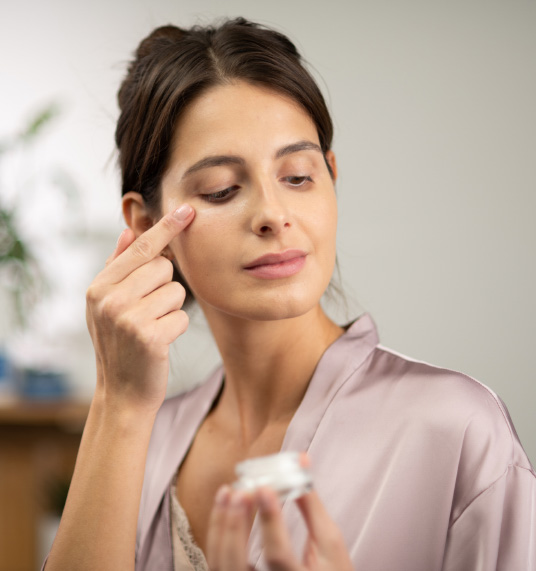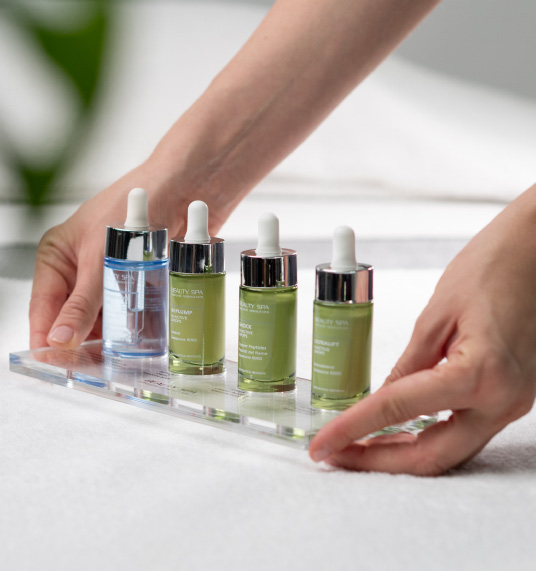CUSTOMIZED cosmetics?
Safety and health for our CONSUMER

The sector of manufacture and marketing of products dedicated to personal care and hygiene has undergone a very important and restrictive evolution in recent years, with the basic aim of guaranteeing the safety and therefore the health of the consumer.
Leaving aside all the legislative changes that have taken place in recent decades, we briefly summarize some fundamental stages:
- Law no. 713 of 1986 and its annexes, which defined the field of application of the cosmetic product and provided the first draft of the annexes which illustrated the details on the chemical categories of the ingredients and the limits or prohibitions in their use. This step was of extreme importance since until then there had been no clearly defined limits.
- EU Regulation no. 1223/2009 of the European Parliament and of the Council on cosmetic products establishes the rules that every cosmetic product placed on the market must comply with in order to guarantee the correct functioning of the internal market and a high level of protection of human health.
On this last point we want to provide more details to clarify controversial positions that create distorted and confusing expectations.
Placing a COSMETIC product on the MARKET
The Product Information File (P.I.F.) must be created to place a cosmetic product on the market. The P.I.F. consists of a technical dossier grouping all the characteristics of the finished product and the studies carried out to demonstrate the effectiveness and safety of the product itself; the P.I.F. is divided into the following steps:
- Defining the Supervisor whose identity must be clearly printed on both primary packaging (bottle, jar, tube, etc.) and on secondary packaging (cases, bags, etc.). The Supervisor is the contact person who is involved by the Authorities of all categories both for health reasons and for simple checks. It is quite clear that the Supervisor – usually the manufacturer – must have the necessary skills to respond to any requests from the Authorities or in turn he/she must be able to manage the problem through an external consultant who interfaces with the manufacturer.
- The Supervisor must register the product to be placed on the market on a European CPNP portal (Cosmetic Products Notification Portal) at least 30 days before its placing on the market. Registration is carried out by communicating:
- The name of the Supervisor;
- Name of a Contact Person, i.e. a telephone number that can be contacted 24 hours a day in case of need;
- The qualitative-quantitative formula of the product;
- Possible presence of nanomaterials and CMR substances (carcinogenic, mutagenic and toxic for reproduction).
- The layout of the packaging components (primary and secondary container).
These documents are intended to be able to quickly trace the Supervisor and view the ingredients to address any adverse reactions or damage suffered by the consumer during use of the product.
The Supervisor, after having notified what stated in paragraph no. 2 on the European portal, must perform:
- The Challenge Test to guarantee the suitability of the preservative system;
- The Safety Assessment, which consists of a report that produces a conclusion on the dermatological activity of the product through the data present in the Safety and Toxicological Data Sheets of each ingredient, their concentration and intended use.
- Furthermore, in order to carry out an appropriate safety assessment, it is recommended to provide supporting tests performed on human subjects, such as the Patch Test or Skin Irritation Test;
- proving the functionality of the product in relation to the boasted properties through effectiveness tests. Example of hydration test if hydration is boasted in the product claim.
- Keeping all the documentation relating to the ingredient sheets and the documents relating to paragraphs no.1 and no.2 available to the competent authorities for a period of ten years after the date on which the last batch of the product was placed on the market.
A continuously EXPANDING market
As can be well understood, these activities require specific skills, which are only possible in certain situations, and costs to be borne which can no longer be absorbed by small productions.
The market for “consultants“, after these rules were passed, has obviously expanded with costs that for a single P.I.F. (Product Information File) can vary between €1,000 and €2,000 to which the costs of the Challenge Test, Patch Test and Effectiveness Tests must be added.
This is a simple economic calculation that must be carried out a priori, before venturing into producing a customized line, especially if it is a line (as in the case of lines in the cosmetology/wellness industry) made up of dozens of products.
The alternative is to produce a large number of pieces by the Supervisor, who will take on all the functions and consequent responsibilities, and then customize a few pieces of product with, for instance, the application of a simple adhesive sticker that identifies the subject who intends to have customization. This would mean the same product for everyone and is anything but a customization; furthermore, we remind you that that simple adhesive sticker still requires registration and notification of the individual product to the European CPNP Portal.
We remind you that non-compliance with the legislative regulations currently in force leads to the risk of withdrawal of all products from the market and the payment of significant sanctions provided for by Legislative Decree no. 204/2015.
In essence, the mere desire to have a cosmetic line with one’s own brand is a very high economic risk in the face of a sales capacity confined to a necessarily restricted market. Furthermore, for those who have been convinced by some “person” to undertake the path of customization, it is advisable to make sure that the manufacturer, as Supervisor, is able to provide, in compliance with Regulation no. 1223/2009, the number and date of notification of all products on the European CPNP Portal, as well as the declaration of the existence of the P.I.F. to be shown during checks by the competent authorities, to avoid incurring the sanctions provided for by Legislative Decree no. 204/2015.
CUSTOMIZED cosmetics?
EYE CONTOUR AREA. What are we talking about?

About the absolutely most fascinating, complex area of our face.
The eyes – actually, the entire eye contour area – express emotions and feelings, moods and thoughts. They talk about us. However, a critical aspect is where and how this happens.
The eye contour area, in fact, is very thin: only zero point five millimeters, compared to 1.7-2.5 millimeters of the rest of the face.
And more than a thousand blinks in twenty-four hours, in addition to the other infinite muscular contractions – both voluntary and involuntary – and the exposure to UV rays during the day, the rubbing against the pillow at night, the crying in front of love films and the sun on your face while driving, and the days spent in front of the PC, the maximum concentration in front of the smartphone and then the sleepless nights, because some worries or opportunities for fun are never missing.
In substance, THE CALLING CARD of our beauty and freshness
The area around the eyes is, in fact, the one that is most affected by our hasty, desperate lifestyle. And unfortunately it is also the first being affected by the passage of time, with changes that begin as early as the age of thirty – reduction in sebaceous secretion, decrease in muscle tone, sagging of the upper eyelid, loss of skin elasticity – and continue inexorably. Daily support is therefore essential, starting from the four main critical issues that all of us have encountered at least once in our lives.
FOUR GRIMACES. And we do not bat an eyelid
The golden rule for a PERFECT eye contour.
Dedicated to the orbicularis oculi muscle, i.e. the one that ensures that the eyelid does not sag, here is a four-move facial gymnastics exercise to combat the signs of aging (from the book “Fit&Face” by Silvia Pengo, Rizzoli). Movements 3 and 4 should be alternated 10 times.
- Close your eyes by raising your eyebrow and relaxing your eyelid as much as possible.
- Gently tighten the eye contour, without forcing.
- Wink against the resistance of your hands. And release gently.
- Open your eyes and mouth as wide as possible to completely flatten your face.
The golden rule for a perfect eye contour. Beauty Spa offers a pool of products dedicated to the eye contour area and the treatment of its blemishes, encompassed in the Eye Tech line by The Specialist. Each intervenes on specific problems, making use of targeted active ingredients. But the game is not played only with these allies: the removal of make-up is also very important, essential every night, to be carried out with specific products for the eye contour area. Carefully removing make-up before going to sleep is an essential step. It is useless to remind you of a technique well known to beauticians: soak the cotton pad in make-up remover and leave it to act on the eyes for a few moments, before passing it horizontally without rubbing. And a good morning starts in the evening.
BEAUTY TIPS
Always keep a pair of sunglasses in your car to avoid excessive squinting on beautiful spring days!
TROUBLES affecting the eye contour area
Swelling
It is the only blemish not linked to age, as it is caused by reduced lymphatic drainage due to tiredness, stress, alcohol, disordered eating, allergies or excess sleep. Swelling – also known as “bags” – forms when the orbital tissue becomes inelastic and sags due to increased fat.
KEYWORDS: draining and improving skin microcirculation.
Dark circles under the eyes
They are the first alarm bell, which indicates the need to undertake a routine with specific eye treatments with anti-aging action. Dark circles are due to the slowdown of skin microcirculation, associated with an accumulation of melanin, particularly visible in the case of light, thin skin. Few hours of sleep, intense mental or sporting activity and psychological tension worsen them.
KEYWORDS: improving skin microcirculation, enhancing hydration and offering light coverage.
Radial wrinkles
We did not want to call them “crow’s feet“, because it makes us sad. They are the classic fine lines that develop around the eyes, and which begin to appear around the age of thirty (unfortunately this is the case!). Two factors underlie this unpleasant blemish: exposure to the sun which causes photo-aging, and facial expressions with infinite facial expressions.
KEYWORDS: lifting action, improving skin hydration, smoothing out, always removing make-up.
Sagging of the eyelid
And so eventually the upper eyelid droops a little (starting from age 40). It is the harsh law of time…this is due to the natural structural failure of the skin tissue combined with a genetic predisposition and the inevitable action of gravity. It is a very unpleasant blemish, which makes the face look older and tired. If until recently the only remedy was cosmetic surgery, today there are specific highly satisfying products.
KEYWORDS: Botox-like lifting effect, redensifying action and skin restructuring.
RECOMMENDED PRODUCTS
block:aicod/correlati-articolo
- uid: uid-7c1443a590caae70
CUSTOMIZED cosmetics?
ENHANCING the benefits of cosmetics

And this also applies to cosmetics: for them to act correctly and effectively, it is important not only to use them as indicated on the label, but also to use them at predetermined times, to enhance their benefits.
Beauty treatments that work in knowledge and respect of circadian rhythms therefore become the essential prerequisite for 24-hour beauty.
Let’s see in detail what it is.
The circadian rhythm
It has a strange name, many of us do not know what it is, but our body knows it very well. The circadian rhythm is a sort of internal clock that regulates the body’s activity throughout the 24 hours and which remains synchronized with the natural cycle of day and night, sunlight, environmental temperature and social stimuli – think of family dinners, always at the same time.
Circadian rhythms are important in determining the sleep and wake cycles of all animals, including humans. Their study also made it possible to detect how these actually direct brain activity, hormone production and cell regeneration, as well as other related biological activities.
The circadian rhythm ultimately affects the correct functioning of our entire body.
The REGULARITY of the circadian rhythm
The progress of our internal clock is regulated by a group of brain cells present in the hypothalamus – called the suprachiasmatic nucleus. This receives information about external light through particular photosensitive cells present in the retina, and organizes the body’s biological rhythms based on the succession of day and night. In turn, this information has important implications on the internal clocks of other organs, such as the heart, the liver and our beloved skin.
Anything that interferes with the regulation of this biological clock – staying up late, changing the time zone, resetting solar or summer time, as well as a change in the length of the day during the change of season – can promote malaise, changes in mood and negatively affect skin aging.
Circadian rhythms influence the skin’s ability to absorb and receive cosmetic products. Therefore it is necessary that these are applied at the right time, taking into consideration that the skin cells have their own particular functioning pattern, which reaches the maximum vitality between midnight and four in the morning and the lowest point at midday.
The epidermis also has its own internal clock, subject to circadian rhythms.
Chrono-cosmetics work in this direction: they respond to the variable needs of the skin throughout the day. Chrono-cosmetics become available when their supply is required and optimized, while their particular nature boost cellular regeneration and repair and allows them to operate in synergy with the skin’s natural processes.
Based on this knowledge, Beauty Spa has developed a high-end home treatment that deeply intertwines with circadian rhythms, optimizing them. For sublimated beauty.
THE PHASES OF THE DAY
6:00 am – 9:00 am
The body slowly gets back into motion. The production of melatonin – the hormone that regulates sleep – ceases, while cortisol levels increase, bringing the body into a state of alert.
It is difficult to wake up if darkness and cold tell our body that it is time to sleep – especially in winter.
9:00 am – 12:00 pm
It is the moment when cortisol reaches its peak and the concentration and activation of the body are optimal. Body temperature continues to rise steadily until midday, along with performance related to key cognitive functions.
3:00 pm – 6:00 pm
At this time of the day the body temperature naturally increases, and the heart and lungs reach their maximum efficiency, while the muscle tone is increased.
6:00 pm – 9:00 pm
At this time the liver and intestines have more difficulty digesting fats and sugars, so dinner must be light. Our mind is freer and more creative ideas arise.
9:00 pm – 12:00 am
The pineal gland in the brain begins to secrete melatonin – the hormone that facilitates falling asleep. The body temperature progressively drops and the body prepares to fall asleep. In this time slot we must pay attention to excessive exposure to smartphones, tablets and PCs, which risks keeping us awake due to their blue light.
12:00 am – 3:00 am
Melatonin levels are maximum and the body is in the deepest phase of rest: in this period of time, the brain gets rid of the toxins accumulated during the day and gets ready for the next day. Memories crystallize, and internal organs relax.
3:00 am – 6:00 am
Body temperature reaches minimum levels. The body’s energies are directed toward other inner activities including the regeneration of epidermis cells. Meanwhile, melatonin levels begin to drop in order to prepare the body for awakening.
Belief or SCIENCE?
Geneticists Hall, Rosbash and Young studied the molecular mechanism that controls the circadian rhythm and on October 2, 2017 they were awarded the Nobel Prize for Medicine.